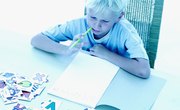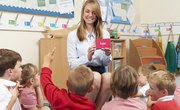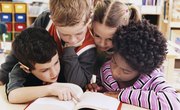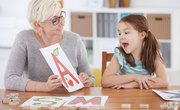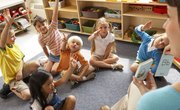Essential questions are guiding statements teacher utilize during planning and instruction. Essential questions are phrased from the student's viewpoint and outline the most important concepts within a subject area. Phonics is an integral unit within a kindergarten language arts curriculum. Although state and district standards ultimately drive a teacher's planning, kindergarten phonics can be described with several over-arching essential questions or ideas.
Sounds Represented by Letters
The purpose of phonics is to make connections between written letters, or graphemes, and sounds, or phonemes. Once kindergarten students recognize the alphabet in print, they 're ready to pair the letters, or combinations of letters, with individual sounds. For example, kindergarten students learn that the letter "s" represents the /s/ sound. Rigorous and repetitive practice with identifying letter sounds helps develop mastery of basic phonics. As students become more accurate and fluent with identifying individual letter sounds, they begin to use those sounds together to create words.
Reading Readiness Skills
Once kindergarten students associate letters with the individual sounds they represent, teachers must guide them to realize how these skills will help them while reading. Although this concept seems obvious, students need explicit instruction and practice applying their new phonics knowledge. In kindergarten, students learn to decode short words, typically consonant-vowel-consonant words. Teachers model how to produce each letter's sound and blend them together to create a word.
Using Letters and Sounds to Write
Similar to reading, kindergarten students require explicit instruction on how to apply their phonics knowledge to writing. While teachers guide students to decode words using letter sounds in reading, they must model for students how to encode words in writing. Kindergarten students learn to sound-out words while writing. Teachers instruct students to slowly say a word, separating it into individual phonemes. Students then write each letter they hear within the word. At the kindergarten level, teachers generally don't expect conventional spelling, but encourage phonetic spelling according to what letters a child hears. For example, a kindergarten student may spell "coat" as "kot."
Combing Letters to Make New Sounds
Near the end of the kindergarten year, students may be ready to study digraphs, which are two letters working together to create a unique sound. Digraphs, such as "th," "sh" and "ch," are more difficult for students to grasp, so they should be reserved for kindergarten students who have mastered individual letter sounds and basic decoding. As students become more aware of text and words while reading, they'll naturally begin to notice digraphs. Teachers can guide this curiosity to help students discover how letters work together to create new sounds.
Related Articles
References
Writer Bio
Based out of Omaha, Neb., Jamie Anderson is a full-time kindergarten teacher. She has been writing educational and child-focused articles since 2011. Anderson holds a Bachelor of Science in elementary education from Kansas State University and is pursuing a Master of Science in early childhood special education from the University of Nebraska.




